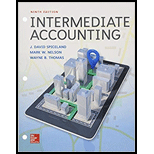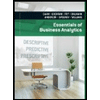
Analysis Case 9–12
Purchase commitments
• Appendix
The management of the Esquire Oil Company believes that the wholesale price of heating oil that they sell to homeowners will increase again as the result of increased political problems in the Middle East. The company is currently paying $0.80 a gallon. If they are willing to enter an agreement in November 2018 to purchase a million gallons of heating oil during the winter of 2019, their supplier will guarantee the price at $0.80 per gallon. However, if the winter is a mild one, Esquire would not be able to sell a million gallons unless they reduced their retail price and thereby increase the risk of a loss for the year. On the other hand, if the wholesale price did increase substantially, they would be in a favorable position with respect to their competitors. The company’s fiscal year-end is December 31.
Required:
Discuss the accounting issues related to the purchase commitment that Esquire is considering.
Want to see the full answer?
Check out a sample textbook solution
Chapter 9 Solutions
INTERMEDIATE ACCOUNTING(LL)-W/CONNECT
- Mason Corporation issued its own $15,000, 120-day, non-interest-bearing note to a bank. The only payment Mason will ever make to the bank will be for $15,000 at the maturity date of the loan, as the bank discounts the note at 8%. The proceeds to Mason are: Ans.arrow_forwardThe future earnings, dividends, and common stock price of Square Technologies Inc. are expected to grow at a rate of 5% per year. The company’s common stock is currently selling for $30 per share and its last dividend was $4. What is the company’s cost of common equity? If the firm’s beta is 1.25, the risk-free rate is 6%, and the market rate of return is 14%, what will be the cost of common equity using the CAPM approach? If you have equal confidence in the inputs used for the two approaches, what is your estimate of the company’s cost of common equity? Berger Paints Corporation has a target capital structure of 35% debt and 65% common equity. Its before tax cost of debt is 9% and the marginal tax rate is 30%. The company’s stock is currently selling at $23 per share and the last dividend was $3. If dividends are expected to grow at a constant rate of 5%, what is the company’s cost of common equity and WACC?arrow_forwardGale Corporation owns 15% of the common stock of Troy Enterprises and uses the fair-value method to account for this investment. Troy reported net income of $140,000 for 2022 and paid dividends of $80,000 on November 1, 2022. How much income should Gale recognize on this investment in 2022? Nonearrow_forward
- Please help me with part Barrow_forwardGale Corporation owns 15% of the common stock of Troy Enterprises and uses the fair-value method to account for this investment. Troy reported net income of $140,000 for 2022 and paid dividends of $80,000 on November 1, 2022. How much income should Gale recognize on this investment in 2022?arrow_forwardI need some help preparing a working paper to consolidate the balance sheets of Paxon and Saxon at January 1, 2022.arrow_forward
- I need some help with letter c. I have understood the mistakes for a and b so you don't need to correct them.arrow_forward11. Kapper Company projects 2025 first quarter sales to be $35,000 and increase by 15% per quarter. Determine the projected sa for 2025 by quarter and in total. Round answers to the nearest dollar. 12. Fana Company manufactures and sells bicycles. A popular model is the XC. The company expects to sell 2.100 XCs in 2024 a 12. Fagg Company manufactures and sells bicycles. A popular model is the XC. The company expects to sell 2,100 XCs in 2024 an 2,000 XCs in 2025. At the beginning of 2024, Friedman has 380 XCs in Finished Goods Inventory and desires to have 50% of the next year's sales available at the end of the year. How many XCs will Fagg need to produce in 2024? Begin by selecting the labels, then enter the amounts to compute the budgeted XCs to be produced. Plus: Total XCs needed Less: Budgeted XCs to be producedarrow_forward16. Camen Company projects the following sales: (Click on the icon to view the projected sales.) Camen collects sales on account in the month after the sale. The Accounts Receivable balance on January 1 is $12,100, which represents December's sales on account. Camen projects the following cash receipts from customers: (Click on the icon to view the cash receipts from customers.) Recalculate cash receipts from customers if total sales remain the same but cash sales are only 30% of the total. Begin by computing the cash sales and sales on account for each month if cash sales are only 30% of the total. January February March Cash sales (30%) Sales on account (70%) Total calor $ 69 29,000 $ 32,000 $ 36,000arrow_forward
- Matt and Meg Comer are married and file a joint tax return. They do not have any children. Matt works as a history professor at a local university and earns a salary of $69,000. Meg works part time at the same university. She earns $51,000 a year. The couple does not itemize deductions. Other than salary, the Comers' only other source of income is from the disposition of various capital assets What is the Comers' tax liability for 2024 if they report the following capital gains and losses for the year?arrow_forwardI need help with this question. I have some of the entries correct but not all of them.arrow_forwardPLEASE HELP ME WITH THIS PROBLEMarrow_forward
 Fundamentals of Financial Management (MindTap Cou...FinanceISBN:9781337395250Author:Eugene F. Brigham, Joel F. HoustonPublisher:Cengage Learning
Fundamentals of Financial Management (MindTap Cou...FinanceISBN:9781337395250Author:Eugene F. Brigham, Joel F. HoustonPublisher:Cengage Learning Essentials Of Business AnalyticsStatisticsISBN:9781285187273Author:Camm, Jeff.Publisher:Cengage Learning,
Essentials Of Business AnalyticsStatisticsISBN:9781285187273Author:Camm, Jeff.Publisher:Cengage Learning,


